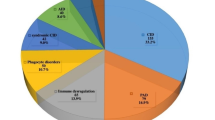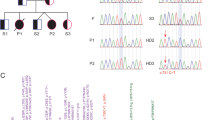Abstract
X-linked agammaglobulinemia is a rare primary immunodeficiency due to a BTK mutation. The patients are characteristically deficient in peripheral B cells and serum immunoglobulins. While they are susceptible to infections caused by bacteria, enteroviruses, and parasites, fungal infections are uncommon in XLA patients. Here, we report a boy of Malay ethnicity who suffered from recurrent upper respiratory tract infections and severe progressive necrotizing fasciitis caused by Saksenaea erythrospora. Immunological tests showed a B cell deficiency and hypogammaglobulinemia. Whole-exome sequencing identified a dinucleotide deletion (c.1580_1581del) in BTK, confirmed by Sanger sequencing and predicted to be disease causing by in silico functional prediction tools (Varsome and MutationTaster2) but was absent in the gnomAD database. This mutation resulted in a frameshift and premature termination (p.C527fs), which disrupted the protein structure. The mother was heterozygous at the mutation site, confirming her carrier status. Flow cytometric analysis of monocyte BTK expression showed it to be absent in the patient and bimodal in the mother. This study describes a novel BTK mutation in a defined hotspot and an atypical fungal phenotype in XLA. Further studies are required to understand the pathogenesis of fungal infection in XLA.




Similar content being viewed by others
Data Availability
The data and material are available upon request.
Code Availability
Not applicable.
References
Vetrie D, Vorechovsky I, Sideras P, Holland J, Davies A, Flinter F, et al. The gene involved in X-linked agammaglobulinemia is a member of the src family of protein-tyrosine kinases. Nature. 1993;361:226–33.
Plebani A, Soresina A, Rondelli R, Amato GM, Azzari C, Cardinale F, et al. Clinical, immunological, and molecular analysis in a large cohort of patients with X-linked agammaglobulinemia: an Italian multicenter study. Clin Immunol. 2002;104:221–30.
Conley ME, Rohrer J, Rapalus L, Boylin EC, Minegishi Y. Defects in early B-cell development: comparing the consequences of abnormalities in pre-BCR signaling in the human and the mouse. Immunol Rev. 2000;178:75–90.
Futatani T, Watanabe C, Baba Y, Tsukada S, Ochs HD. Bruton’s tyrosine kinase is present in normal platelets and its absence identifies patients with X-linked agammaglobulinaemia and carrier females. Br J Haematol. 2001;114:141–9.
Winkelstein JA, Marino MC, Lederman HM, Jones SM, Sullivan K, Burks AW, et al. X-Linked agammaglobulinemia. Medicine. 2006;85:193–202.
Bearden D, Collett M, Quan PL, Costa-Carvalho BT, Sullivan KE. Enteroviruses in X-linked agammaglobulinemia: update on epidemiology and therapy. J Allergy Clin Immunol Pract. 2016;4:1059–65.
Lougaris V, Soresina A, Baronio M, Montin D, Martino S, Signa S, et al. Long-term follow-up of 168 patients with X-linked agammaglobulinemia reveals increased morbidity and mortality. J Allergy Clin Immunol. 2020;146:429–37.
Pac MM, Bernatowska EA, Kierkuś J, Ryżko JP, Cielecka-Kuszyk J, Jackowska T, et al. Gastrointestinal disorders next to respiratory infections as leading symptoms of X-linked agammaglobulinemia in children – 34-year experience of a single center. Arch Med Sci. 2017;13:412–7.
Macura AB, Macura-Biegun A, Pawlik B. Susceptibility to fungal infections of nails in patients with primary antibody deficiency. Comp Immunol Microbiol Infect Dis. 2003;26:223–32.
Nishi K, Kawai T, Kubota M, Ishiguro A, Onodera M. X-linked agammaglobulinemia complicated with pulmonary aspergillosis. Pediatr Int. 2018;60:90–2.
Chear CT, Nallusamy R, Canna SW, Chan KC, Baharin MF, Hishamshah M, et al. A novel de novo NLRC4 mutation reinforces the likely pathogenicity of specific LRR domain mutation. Clin Immunol. 2020;211:108328.
Kopanos C, Tsiolkas V, Kouris A, Chapple CE, Albarca Aguilera M, Meyer R, et al. VarSome: the human genomic variant search engine. Bioinformatics. 2019;35:1978–80.
Schwarz JM, Cooper DN, Schuelke M, Seelow D. MutationTaster2: mutation prediction for the deep-sequencing age. Nat Methods. 2014;11:361–2.
Chear CT, Ripen AM, Mohamed SAS, Dhaliwal JS. A novel BTK gene mutation creates a de-novo splice site in an X-linked agammaglobulinemia patient. Gene. 2015;560:245–8.
White TJ, Bruns T, Lee S, Taylor J. Amplification and Direct Sequencing of Fungal Ribosomal RNA Genes for Phylogenetics. PCR Protocols: A Guide to Methods and Applications. New York: New York: Academic Press; 1990. p. 315–22.
Antonarakis SE, Cooper DN. 6 - Human Genomic Variants and Inherited Disease: Molecular Mechanisms and Clinical Consequences. Emery and Rimoin’s Principles and Practice of Medical Genetics and Genomics. 7th ed. Boston: Boston: Academic Press; 2019. p. 125–200.
Sehn JK. Chapter 9 - Insertions and Deletions (Indels). In: Clinical Genomics. Cambridge: Academic Press; 2015. p. 129–50.
Moschese V, Orlandi P, Plebani A, Arvanitidis K, Fiorini M, Speletas M, et al. X-chromosome inactivation and mutation pattern in the Bruton’ s tyrosine kinase gene in patients with X-linked agammaglobulinemia. Mol Med. 2000;6:104–13.
Conley ME, Fitch-Hilgenberg ME, Cleveland JL, Parolini O, Rohrer J. Screening of genomic DNA to identify mutations in the gene for Bruton’s tyrosine kinase. Hum Mol Genet. 1994;3:1751–6.
Ohta Y, Haire RN, Litman RT, Fu SM, Nelson RP, Kratz J, et al. Genomic organization and structure of Bruton agammaglobulinemia tyrosine kinase: localization of mutations associated with varied clinical presentations and course in X chromosome-linked agammaglobulinemia. Proc Natl Acad Sci. 1994;91:9062–6.
Joseph RE, Kleino I, Wales TE, Xie Q, Fulton DB, Engen JR, et al. Activation loop dynamics determine the different catalytic efficiencies of B cell- and T cell-specific Tec kinases. Sci Signal. 2013;6:ra76.
Mao C, Zhou M, Uckun FM. Crystal structure of Bruton’s tyrosine kinase domain suggests a novel pathway for activation and provides insights into the molecular basis of X-linked agammaglobulinemia. J Biol Chem. 2001;276:41435–43.
Wang Q, Vogan EM, Nocka LM, Rosen CE, Zorn JA, Harrison SC, et al. Autoinhibition of Bruton’s tyrosine kinase (Btk) and activation by soluble inositol hexakisphosphate. eLife. 2015;4:e06074.
Tangye SG, Al-Herz W, Bousfiha A, Chatila T, Cunningham-Rundles C, Etzioni A, et al. Human inborn errors of immunity: 2019 update on the classification from the International Union of Immunological Societies Expert Committee. J Clin Immunol. 2020;40:24–64.
Eades CP, Armstrong-James DPH. Invasive fungal infections in the immunocompromised host: mechanistic insights in an era of changing immunotherapeutics. Med Mycol. 2019;57:S307–17.
Lanternier F, Cypowyj S, Picard C, Bustamante J, Lortholary O, Casanova J-L, et al. Primary immunodeficiencies underlying fungal infections. Curr Opin Pediatr. 2013;25:736–47.
Templeton SP, Rivera A, Hube B, Jacobsen ID. Editorial: immunity to human fungal pathogens: mechanisms of host recognition, protection, pathology, and fungal interference. Front Immunol. 2018;9:2337.
Mirsafian H, Ripen AM, Leong W-M, Chear CT, Mohamad SB, Merican AF. Transcriptome profiling of monocytes from XLA patients revealed the innate immune function dysregulation due to the BTK gene expression deficiency. Sci Rep. 2017;7:6836.
Goodridge HS, Underhill DM, Touret N. Mechanisms of fc receptor and Dectin-1 activation for phagocytosis: mechanisms of Fc receptor and Dectin-1 activation for phagocytosis. Traffic. 2012;13:1062–71.
Weerasinghe H, Traven A. Immunometabolism in fungal infections: the need to eat to compete. Curr Opin Microbiol. 2020;58:32–40.
Weber ANR, Bittner Z, Liu X, Dang T-M, Radsak MP, Brunner C. Bruton’s tyrosine kinase: an emerging key player in innate immunity. Front Immunol. 2017;8:1454.
Chamilos G, Lionakis MS, Kontoyiannis DP. Call for action: invasive fungal infections associated with ibrutinib and other small molecule kinase inhibitors targeting immune signaling pathways. Clin Infect Dis. 2018;66:140–8.
Ghez D, Calleja A, Protin C, Baron M, Ledoux M-P, Damaj G, et al. Early-onset invasive aspergillosis and other fungal infections in patients treated with ibrutinib. Blood. 2018;131:1955–9.
Varughese T, Taur Y, Cohen N, Palomba ML, Seo SK, Hohl TM, et al. Serious infections in patients receiving ibrutinib for treatment of lymphoid cancer. Clin Infect Dis. 2018;67:687–92.
El-Sayed ZA, Abramova I, Aldave JC, Al-Herz W, Bezrodnik L, Boukari R, et al. X-linked agammaglobulinemia (XLA): phenotype, diagnosis, and therapeutic challenges around the world. World Allergy Organ J. 2019;12:100018.
Fiedler K, Sindrilaru A, Terszowski G, Kokai E, Feyerabend TB, Bullinger L, et al. Neutrophil development and function critically depend on Bruton tyrosine kinase in a mouse model of X-linked agammaglobulinemia. Blood. 2011;117:1329–39.
Urban CF, Nett JE. Neutrophil extracellular traps in fungal infection. Semin Cell Dev Biol. 2019;89:47–57.
Blez D, Blaize M, Soussain C, Boissonnas A, Meghraoui-Kheddar A, Menezes N, et al. Ibrutinib induces multiple functional defects in the neutrophil response against Aspergillus fumigatus. Haematologica. 2020;105:478–89.
Stadler N, Hasibeder A, Lopez PA, Teschner D, Desuki A, Kriege O, et al. The Bruton tyrosine kinase inhibitor ibrutinib abrogates triggering receptor on myeloid cells 1-mediated neutrophil activation. Haematologica. 2017;102:e191–4.
de Oliveira MA, dos Santos Dantas PH, Figueira Marques Silva-Sales M, Sales-Campos H. The role of the triggering receptor expressed on myeloid cells-1 (TREM-1) in non-bacterial infections. Crit Rev Microbiol. 2020;46:237–52.
Schröder A, Gerin A, Firth GB, Hoffmann KS, Grieve A, Oetzmann von Sochaczewski C. A systematic review of necrotising fasciitis in children from its first description in 1930 to 2018. BMC Infect Dis. 2019;19:317.
Goldstein EJC, Anaya DA, Dellinger EP. Necrotizing soft-tissue infection: diagnosis and management. Clin Infect Dis. 2007;44:705–10.
Alvarez E, Garcia-Hermoso D, Sutton DA, Cano JF, Stchigel AM, Hoinard D, et al. Molecular phylogeny and proposal of two new species of the emerging pathogenic fungus Saksenaea. J Clin Microbiol. 2010;48:4410–6.
Relloso S, Romano V, Landaburu MF, Herrera F, Smayevsky J, Veciño C, et al. Saksenaea erythrospora infection following a serious sailing accident. J Med Microbiol. 2014;63:317–21.
Hospenthal DR, Chung KK, Lairet K, Thompson EH, Guarro J, Renz EM, et al. Saksenaea erythrospora infection following combat trauma. J Clin Microbiol. 2011;49:3707–9.
Mukherjee B, Kundu D. Necrotizing fungal infection due to Saksenaea erythrospora: a case report and review of literature. Indian J Ophthalmol. 2018;66:1513–6.
Tendolkar U, van Diepeningen A, Joshi A, Koomen J, Bradoo R, Baveja S, et al. Rhinosinusitis caused by Saksenaea erythrospora in an immunocompetent patient in India: a first report. JMM Case Rep. 2015;2:1–4.
Chander J, Singla N, Kaur M, Punia RS, Attri A, Alastruey-Izquierdo A, et al. Saksenaea erythrospora, an emerging mucoralean fungus causing severe necrotizing skin and soft tissue infections – a study from a tertiary care hospital in north India. Infect Dis Ther. 2017;49:170–7.
Labuda R, Bernreiter A, Hochenauer D, Schüller C, Kubátová A, Strauss J, et al. Saksenaea dorisiae sp. nov., a new opportunistic pathogenic fungus from Europe. Int J Microbiol. 2019;2019:1–11.
Futatani T, Miyawaki T, Tsukada S, Hashimoto S, Kunikata T, Arai S, et al. Deficient expression of Bruton’s tyrosine kinase in monocytes from X-linked agammaglobulinemia as evaluated by a flow cytometric analysis and its clinical application to carrier detection. Blood. 1998;91:595–602.
Chear CT, Gill HK, Ramly NH, Dhaliwal JS, Bujang N, Ripen AM, et al. A novel Bruton’s tyrosine kinase gene (BTK) invariant splice site mutation in a Malaysian family with X-linked agammaglobulinemia. Asian Pac J Allergy Immunol. 2013;31:320–4.
Acknowledgements
We would like to thank the Director General of Health Malaysia for his permission to publish this article. We thank all the clinicians who have been involved in the patient’s management. Also, we gratefully acknowledge Koay BT and Chiow MY for helpful discussions, and Gill HK for language editing.
Funding
This project was supported by the Ministry of Health, Malaysia, Grant NMRR-16-892-31023.
Author information
Authors and Affiliations
Contributions
C.T.C. performed experiments, analyzed results, and drafted manuscript; R.N. and K.W.C. managed and treated the patient, provided a clinical summary, and revised manuscript; R.M.T. performed and analyzed fungal identification tests and drafted manuscript; M.F.B. and S.B.M. involved in data interpretation and revised manuscript; S.N.H.S.Y. performed the experiment; P.B.K. involved in data interpretation; A.M.R. initiated and designed the study, analyzed results, and revised manuscript. All authors read and approved the final manuscript.
Corresponding author
Ethics declarations
Ethics Approval
This study was approved by the Medical Research Ethics Committee, Ministry of Health, Malaysia [KKM/NIHSEC/P16-837].
Consent to Participate
Informed consent was obtained from the study subjects prior to sampling.
Consent for Publication
Informed consent was obtained from the study subjects prior to publication.
Conflict of Interest
The authors declare no conflict of interest.
Additional information
Publisher’s Note
Springer Nature remains neutral with regard to jurisdictional claims in published maps and institutional affiliations.
Rights and permissions
About this article
Cite this article
Chear, C.T., Nallusamy, R., Chan, K.C. et al. Atypical Presentation of Severe Fungal Necrotizing Fasciitis in a Patient with X-Linked Agammaglobulinemia. J Clin Immunol 41, 1178–1186 (2021). https://doi.org/10.1007/s10875-021-01017-3
Received:
Accepted:
Published:
Issue Date:
DOI: https://doi.org/10.1007/s10875-021-01017-3




